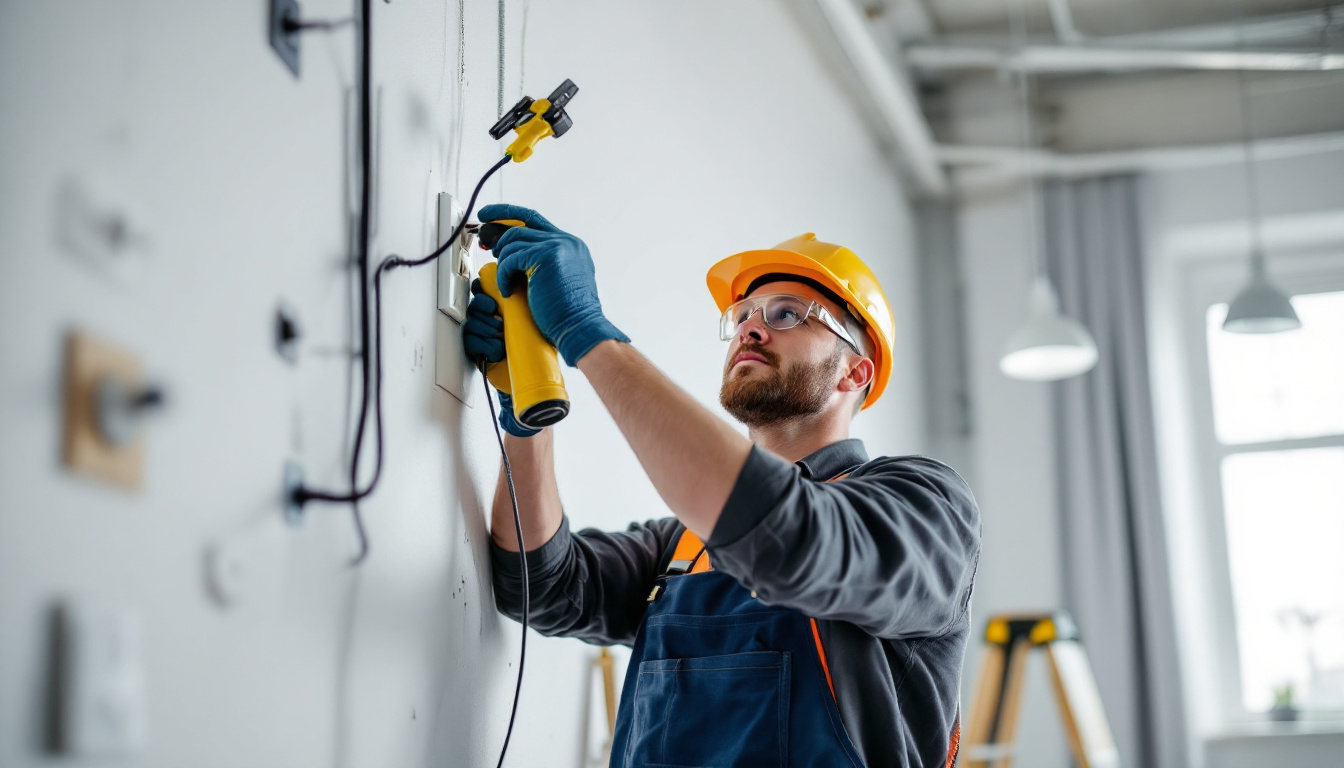
In the world of electrical installations, especially in lighting, the outlet box serves as a crucial component. For lighting contractors, mastering the art of extending outlet boxes can significantly enhance the efficiency and safety of their projects. This article delves into the essential resources and techniques that lighting contractors can utilize to master the extension of outlet boxes, ensuring both compliance with regulations and satisfaction of their clients.
Before diving into the methods of extending outlet boxes, it’s essential to understand what they are and their role in electrical systems. Outlet boxes are designed to house electrical connections and protect wiring from damage. They also provide a secure mounting point for switches, outlets, and fixtures.
These boxes come in various sizes and materials, including plastic and metal, and are classified based on their intended use—whether for new construction, remodeling, or outdoor applications. Familiarity with these types will help contractors choose the right box for their specific project needs. For instance, plastic boxes are lightweight and resistant to corrosion, making them ideal for indoor use, while metal boxes offer superior durability and grounding capabilities, often preferred in commercial settings.
There are several types of outlet boxes that contractors should be aware of. Standard outlet boxes are used for most residential applications, while deeper boxes may be necessary for accommodating larger fixtures or multiple connections. Additionally, weatherproof boxes are essential for outdoor installations, ensuring that the electrical components remain protected from the elements. Some specialized boxes, such as low-voltage or retrofit boxes, cater to specific needs like data and communication wiring, which is increasingly important in our technology-driven world.
Understanding the differences and applications of these boxes can help contractors make informed decisions, leading to more efficient installations and fewer callbacks. Moreover, the choice of outlet box can significantly impact the overall aesthetic of a space; for example, decorative or architectural boxes can enhance the visual appeal of a room while still meeting functional requirements.
Compliance with local electrical codes is paramount when working with outlet boxes. These codes dictate the installation methods, types of boxes allowed, and safety measures that must be taken to protect both the installer and the end-user. It is crucial for contractors to stay updated on these regulations to avoid potential fines and ensure the safety of their installations. Many municipalities also require inspections at various stages of the installation process, which can help catch any issues early on and ensure adherence to safety standards.
Furthermore, safety regulations often require specific practices, such as securing boxes to framing members and ensuring proper grounding. Familiarity with these requirements not only enhances safety but also boosts the contractor’s reputation for quality workmanship. Additionally, understanding the importance of using the correct box fill calculations can prevent overheating and electrical failures, which are critical for maintaining the integrity of the electrical system. By prioritizing compliance and safety, contractors can foster trust with their clients and contribute to a safer electrical environment overall.
Extending an outlet box may be necessary for various reasons, such as accommodating new fixtures, changing room layouts, or simply ensuring that the box is flush with the wall surface. Here are some effective techniques that lighting contractors can employ to extend outlet boxes safely and efficiently.
Box extenders are a popular solution for extending outlet boxes. These devices are designed to fit over existing boxes, allowing for a seamless transition to the wall surface. They come in various sizes and materials, ensuring compatibility with different box types and wall finishes.
To install a box extender, simply remove the cover plate, attach the extender to the existing box, and then reinstall the cover plate. This method is quick and minimizes the need for extensive modifications to the existing wiring.
In some cases, a custom extension may be required, especially when dealing with unique wall configurations or specific design requirements. Contractors can create a custom extension using wood or metal, ensuring that it adheres to the necessary safety standards.
When building a custom extension, it is essential to ensure that the new extension is securely attached to the existing box and that all wiring is properly insulated and protected. This approach may take more time but can provide a tailored solution for challenging installations.
Adjustable outlet boxes are another innovative solution for extending outlet boxes. These boxes can be adjusted to fit various wall thicknesses, making them ideal for remodels and installations in older homes where wall depths may vary.
By using adjustable boxes, contractors can save time and effort, as they eliminate the need for multiple box sizes on the job site. This versatility also allows for a cleaner and more professional finish, as the box can be flush with the wall surface regardless of the wall thickness.
Having the right tools and equipment is essential for any lighting contractor looking to extend outlet boxes effectively. The following tools are invaluable for ensuring precision and safety during the installation process.
Basic hand tools such as screwdrivers, pliers, and wire strippers are fundamental for any electrical work. These tools are essential for removing cover plates, securing boxes, and making necessary wire connections. Investing in high-quality hand tools can significantly improve efficiency and reduce the likelihood of injuries.
In addition to these basics, a level is crucial for ensuring that the outlet box is installed straight and flush with the wall. A measuring tape will also help in determining the correct placement of the box, especially in custom installations.
power tools can expedite the process of extending outlet boxes, particularly when cutting or drilling is involved. A cordless drill is invaluable for driving screws quickly and efficiently, while a reciprocating saw or jigsaw can be used for cutting openings in walls or creating custom extensions.
Using power tools not only saves time but also allows for more precise cuts and installations. However, it is essential to prioritize safety by using appropriate personal protective equipment and following manufacturer guidelines.
Once the outlet box extension is complete, testing equipment is necessary to ensure that the installation is safe and functional. A multimeter can be used to check for proper voltage and continuity, while a circuit tester can help verify that the outlet is wired correctly.
Conducting thorough testing before closing up walls or installing fixtures is crucial. This practice not only prevents future issues but also enhances the contractor’s credibility and reliability in the eyes of clients.
To ensure that outlet box extensions are successful, contractors should adhere to several best practices. These practices can help streamline the installation process and enhance the overall quality of the work.
Before beginning any installation, careful planning and layout are essential. This involves determining the location of the outlet box, ensuring that it is positioned correctly for the intended fixture or outlet, and verifying that it complies with local codes.
Creating a detailed plan can help identify potential challenges early in the process, allowing contractors to address them proactively. This foresight can save time and resources during the installation phase.
Proper wiring techniques are critical for ensuring safety and functionality. Contractors should always follow the manufacturer’s instructions and local codes when making electrical connections. This includes using the correct wire gauge, securing connections with wire nuts, and ensuring that all wires are properly insulated.
Additionally, labeling wires can help simplify future troubleshooting and maintenance. This practice not only enhances safety but also provides peace of mind for both the contractor and the client.
Maintaining thorough documentation of all installations is vital for accountability and future reference. Contractors should keep records of the types of outlet boxes used, any modifications made, and any inspections conducted.
Moreover, effective communication with clients is essential throughout the installation process. Keeping clients informed about the progress, any challenges encountered, and the solutions implemented can foster trust and satisfaction.
The electrical industry is constantly evolving, with new technologies, techniques, and regulations emerging regularly. For lighting contractors, continuing education is crucial for staying competitive and ensuring the highest standards of workmanship.
Joining industry associations can provide valuable resources and networking opportunities for lighting contractors. Organizations such as the National Electrical Contractors Association (NECA) offer training programs, certifications, and access to industry standards that can enhance a contractor’s skills and knowledge.
Obtaining certifications in specific areas, such as energy efficiency or advanced lighting systems, can also set contractors apart from their competitors and demonstrate a commitment to quality and professionalism.
In addition to formal education, online resources and training programs can be incredibly beneficial. Many websites and platforms offer courses on electrical installations, including outlet box extensions, that contractors can access at their convenience.
Webinars, video tutorials, and forums can provide insights into the latest techniques and best practices, allowing contractors to learn from industry experts and peers. Engaging with these resources can lead to improved skills and a more successful business.
Networking with other professionals in the industry can lead to valuable collaborations and knowledge sharing. Attending trade shows, workshops, and local meetups can provide opportunities to connect with other contractors, suppliers, and industry leaders.
These connections can lead to partnerships that enhance service offerings, as well as referrals that can help grow a contractor’s business. Building a strong network is an invaluable asset in the competitive world of lighting contracting.
Mastering the extension of outlet boxes is a vital skill for lighting contractors. By understanding the various types of outlet boxes, employing effective techniques, utilizing the right tools, and adhering to best practices, contractors can ensure high-quality installations that meet client expectations and regulatory standards.
Moreover, investing in continuing education and networking can further enhance a contractor’s expertise and reputation in the industry. By leveraging these resources and techniques, lighting contractors can position themselves as leaders in their field, delivering exceptional service and craftsmanship in every project.
Ready to take your lighting installations to the next level? LumenWholesale is here to support your mastery of extending outlet boxes with our extensive range of spec-grade lighting products. Enjoy unbeatable wholesale prices and the convenience of cutting out the middleman, ensuring you get the most value for your investment. Our commitment to quality and affordability, paired with free shipping on bulk orders, makes us the go-to source for contractors seeking reliability and performance. Elevate your lighting projects today by visiting Wholesale Lighting at the Best Value and discover the difference that LumenWholesale can make.

Discover expert tips on optimizing your living room ceiling lighting for maximum efficiency.

Discover the often-overlooked aspects of direct lighting that even seasoned contractors miss.

Discover effective strategies for training your team in the installation and maintenance of outdoor solar strip lights.

Discover why staying updated on ceiling room lights is crucial for lighting contractors.